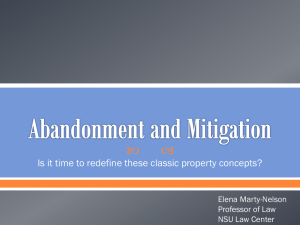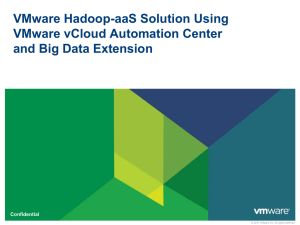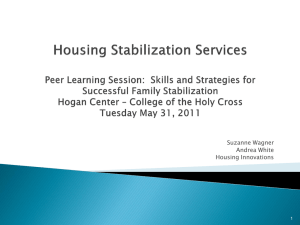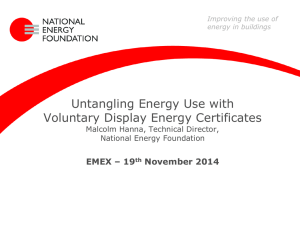Greg Hale - Pace Law School
advertisement
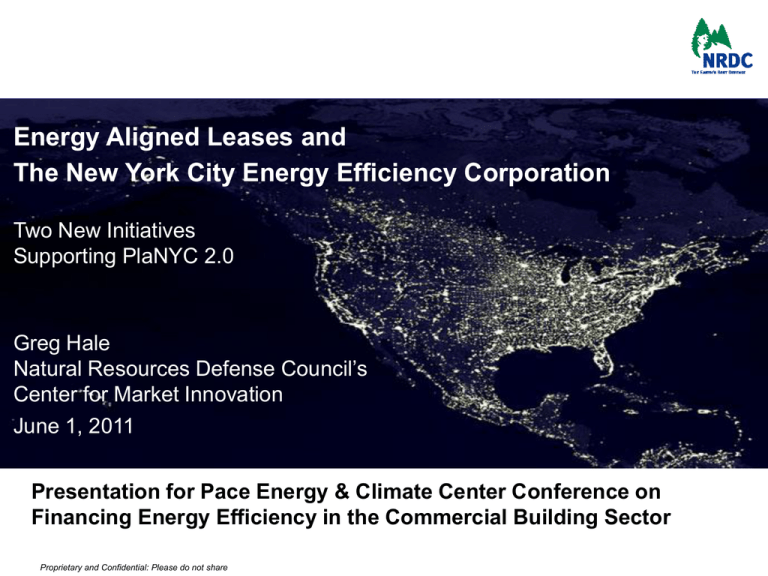
Energy Aligned Leases and The New York City Energy Efficiency Corporation Two New Initiatives Supporting PlaNYC 2.0 Greg Hale Natural Resources Defense Council’s Center for Market Innovation June 1, 2011 Presentation for Pace Energy & Climate Center Conference on Financing Energy Efficiency in the Commercial Building Sector Proprietary and Confidential: Please do not share NRDC’s Center for Market Innovation NRDC’s Center for Market Innovation (CMI) works to advance market mechanisms that channel capital toward investments that are both environmentally sustainable and economically profitable. Our goal is to help finance the shift to a green economy. CMI’s three current areas of focus and their respective goals are: 1. Scaling and Financing the Energy Efficiency Retrofit Market – To measurably reduce energy use by, and greenhouse gas emissions from, the built environment 2. Promoting Clean Energy Technologies – To create the conditions for rapid, responsible and sustainable deployment of clean technologies through policy, infrastructure support and financial community engagement 3. Decarbonizing Industry – To identify low-carbon technologies and best management practices that will help industry play a key role in reducing U.S. emissions 2 Proprietary and Confidential: Please do not share Buildings are an Important Part of the Solution The Problem: Burning fossil fuels to generate electricity causes a wide range of adverse environmental and public health impacts 72% of electricity generated in the United States came from fossil fuels, with just under 1/2 coming from coal (2005 figures) Fossil fuel combustion for electricity is responsible for: about 2/3 of US sulfur dioxide emissions, a primary cause of acid rain roughly 1/4 of the US emissions of nitrogen oxide (NOx), a precursor to smog 40 percent of anthropogenic carbon dioxide (CO2) emissions in the United States substantial releases of mercury into the environment consuming significant amounts of water 3 Proprietary and Confidential: Please do not share Buildings are an Important Part of the Solution Buildings account for roughly 40 percent of total US energy consumption and approximately 70 percent of US electricity consumption. Buildings account for about 40 percent of carbon dioxide emissions in the United States, including emissions from electricity generation and direct use of fossil fuels. Approximately 20% from residential buildings, and 20% from commercial buildings In dense urban environments such as New York City, buildings are responsible for up to 80% of the city’s GHG emissions. It is estimated that 80-90% of the buildings that will exist in the United States in 2030 already exist today. So to achieve major energy savings and GHG emission reductions from the real estate sector, we must focus on retrofitting existing building stock. 4 Proprietary and Confidential: Please do not share Collaborative Opportunity for Owners and Tenants In NYC, the largest 2% of buildings (22,000 bldgs) account for about 50% of the City’s built space (by square footage) and a large % of the City’s GHG emissions Majority of these are multi-tenant commercial office buildings •Roughly 50-70% of energy usage consumed within Tenant spaces •Remaining 30-50% consumed by central systems and common spaces •Landlord/Tenant structure creates challenges, but also presents opportunities To build retrofit demand and drive deeper retrofits, we must make a clear value proposition to both Landlords and Tenants Tenant Value Proposition •Lower direct operating expenses from energy savings (from high performance buildout of T’s submetered premises) •Lower pass through of common area/central system energy expenses (from LL’s retrofit of central systems) •Better employee attraction, retention and productivity (from inclusion of indoor environmental qualitiy measures in high performance buildout of T’s premises) Owner Value Proposition •Lower costs of operating common area/central systems •Competitive Advantage – increased occupancy – tenant demand for efficient buildings 5 Proprietary and Confidential: Please do not share NRDC’s Energy Efficiency Lease Forum To help Landlords and Tenants understand the mutual benefits of efficiency, NRDC convened energy efficiency lease forum in 2009 in conjunction with NYSERDA and HR&A, to develop a set of principles to serve as a best practices guide to negotiating the energy provisions of commercial leases. Forum included owners, tenants, brokers, leasing attorneys, City leasing representatives, utilities, NGOs, and consultants Principles implemented by Deutsche Bank in negotiating with building owners around the world, to achieve increased energy efficiency in premises leased by DB NRDC, EDF and Cycle-7 are collaborating to develop a training curriculum to present the Energy Efficiency Lease Principles to various stakeholders in commercial leasing transactions •Brokers •Leasing Attorneys •Building Owners •Major Tenants 6 Proprietary and Confidential: Please do not share NRDC’s Energy Efficiency Lease Principles 1. LANDLORD SHOULD OPERATE THE BUILDING AND TENANT ITS PREMISES AS EFFICIENTLY AS IS FEASIBLE. • • • • Landlord should benchmark energy use for the Building annually LL and Tenant should retro-commission their respective premises at agreed intervals Suggested provisions re: operations Tenant electricity requirements – including consequences for over-reserving o LL right to reclaim; or o T charged for unused capacity 2. TO THE EXTENT FEASIBLE, BOTH CONSUMPTION AND DEMAND FOR RESOURCES THROUGHOUT THE BUILDING SHOULD BE MEASURABLE AND TRANSPARENT TO BOTH LANDLORD AND TENANT. • • • • • LL should submeter resource use in Tenant space wherever technically feasible Where submetering of Tenant space is infeasible, LL should submeter by floor Base Building electric usage should be calculated, to the maximum extent feasible, utilizing submeters to exclude Tenant spaces LL should annually report to Tenant the benchmarked resource usage of the Building Tenant should annually report to LL any resource usage in Tenant space that is directly metered by the applicable utility 7 Proprietary and Confidential: Please do not share NRDC’s EE Lease Principles – Split Incentive The ‘Split Incentive’ issue arises where the respective costs and benefits of installed energy conservation measures would not be equitably allocated between landlord and tenant under the terms of existing leases • Most pronounced in modified gross lease, common in NY, LA, SF, Chicago and other major metropolitan areas Final NRDC EE Lease Principle addresses the Split Incentive: 3. For installation of any energy conservation measure, responsibility for capital expense and benefit of savings should reside with the same party • Landlord should assume responsibility for all base building operating expenses, increasing rent annually to account for rising operations costs OR 3A All of the savings achieved by virtue of an installed ECM should be available to pay for the improvement • Landlord should have the right to pass through capital expense to the extent of (Projected/Actual) dollar savings 8 Proprietary and Confidential: Please do not share NYC Energy Aligned Lease Initiative Model Lease Provision to address the ‘split incentive’ • Equitably allocates the costs and benefits of energy efficiency building retrofits among Landlord and Tenants Developed through several meetings with working group comprised of NYC building owners, major tenants and property managers Allows pass-through of capital expenditures (including soft costs) made by Landlords on Energy Conservation Measures (ECMs) • Pass-Through/Recovery based upon projected energy savings from ECMs • Annual recovery limited to 80% of savings projected to be realized each year • Resulting extension of recovery period provides buffer to Tenant from inaccurate projections Modeling tool demonstrates insignificance of the risk of ECM underperformance to the overall economics of the lease – both for LL’s and T’s Energy Aligned Provision included in new lease at 7 World Trade Center between Silverstein Properties and WilmerHale • NYC looking for additional opportunities to execute private sector leases including the energy aligned lease provision 9 Proprietary and Confidential: Please do not share New York City Energy Efficiency Corporation (NYCEEC) Public / Private Partnership created to catalyze and scale NYC retrofit market • • Structured as an independent non-profit corporation – will seek 501(c)(3) status from IRS Public Sector Capital (Stimulus Funds) will be used to leverage substantial Philanthropic and Private Sector capital investments Self-Sustaining Entity • • • $37.5 Million seed capital from DOE formula and competitive EECBG awards Transaction Fees, Interest Rate Spreads Return on Potential Investments in Retrofit Transactions Three Major Areas of Function • Financial Intermediary Credit Enhancement Revolving Loan Fund • Generating Retrofit Demand • Information Center – Existing Rebates, Incentives & Tax Credits Targeted Outreach Broad Public Awareness Marketing Campaigns Could Support Retrofits of Central Systems and/or Tenant Spaces Workforce & Economic Development Likely Initial Focus on Commercial Office and Multifamily (Affordable/Market Rate) 10 Proprietary and Confidential: Please do not share NYCEEC will use $37.5 M of EECBG stimulus funding to leverage additional philanthropic and private capital Approx $30 M of the EECBG award will fund various financing programs • Will likely include revolving loan fund and credit enhancement mechanisms • Will seek to increase available credit enhancement facilities with additional layer of PRI capital from philanthropic foundations Design specific mechanisms for different RE sectors • Anticipate initial DOE and PRI credit enhancement facilities to leverage $150 - $300 M of private sector EE retrofit investment Remaining $7.5M of EECBG funding will be used for generating retrofit demand, measurement & verification, reporting, workforce development, advisory services and administrative costs Potential secondary market investment opportunities • Seasoned pools of secured/unsecured loans from the RLF • Aggregated, credit enhanced private sector retrofit loans • Possible PACE Commercial financings, pending state legislative action Proprietary and Confidential: Please do not share NYCEEC - Potential Additional Funding Sources Philanthropic Foundations • Grants for Administrative and Program Expenses • Program Related Investments Private Equity / Commercial Debt • Supported by credit enhancement Utility Sector Funding • Systems Benefit Charge / Regional Greenhouse Gas Initiative • Demand Management – Capital Deferral / EE RFP Programs ISO Forward Capacity Markets Corporate Marketing / Offsets Treasury Dept. CDFI Funding Efficiency Credits/Monetizing other environmental attributes 12 Proprietary and Confidential: Please do not share NYCEEC Team NYCEEC CEO: Susan Leeds Founding Board Members: • David Bragdon (NYC Mayor’s Office of Long-Term Planning & Sustainability) • Jeff Brodsky (Related Companies) • Greg Hale (Natural Resources Defense Council) • Gary Hattem (Deutsche Bank) • Sarita James (Citi) • Terri Ludwig (Enterprise Community Partners) • Ariella Maron (NYC Department of General Administrative Services) • Sergei Mahnovski (NYC Department of Environmental Protection) Financial Advisor: Forsyth Street Advisors / HR&A Advisors 13 Proprietary and Confidential: Please do not share NYCEEC Proposed Program Structure NYSERDA ARRA $ Generating Demand • Information Center NYC DCAS NYC Energy Efficiency Corporation • Marketing Campaigns •Targeted Outreach Philanthropic $ Workforce Development •Amalgamated Green •Contractor Certification •Transaction Fees •Investment Returns Financial Services Credit Enhancement •Loan Loss Reserve Revolving Loan Fund Project Level Grants and Incentives Building Retrofits 14 Proprietary and Confidential: Please do not share Private Capital •Commercial Debt •Private Equity Contact Information Greg Hale Senior Financial Policy Specialist, NRDC’s Center for Market Innovation 40 West 20th Street, New York, NY 10011 Office: 212-727-4613 ghale@nrdc.org | www.nrdc.org 15 Proprietary and Confidential: Please do not share



